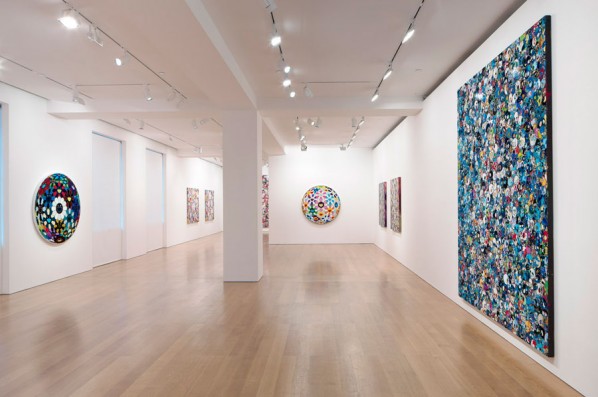
What is Art?For those of us born in Asia, it remains an ever important question. The reason is that what we today define as Art represents the path followed by Western art history and yet here in the East, we have our own history. To survive as artists, we must learn to resolve the collision of these two cultures.
My own personal position is drawn from how well I can arrange the unique flowers of Asia, moreover the ever strange blossoms that have bloomed in the madness of the defeated culture of postwar Japan, into work that will live within the confines of Western art history.
—Takashi Murakami
For this exhibition, Takashi Murakami's first in Gagosian Gallery, Hong Kong, he will present a new group of original works in multiple variations on two of his signature motifs: flowers and skulls, exploring one of the central dichotomies of his art—between joy and terror, his optimistic magnanimity as an artist and his pessimistic perspective on postwar Japan. Here, this dichotomy is symbolized by the stark contrast of bright smiling flowers and disturbing, menacing representations of skulls. Whether depicted as single iconic "portraits" or in complex clusters of virtuoso composition and paintwork that combine painstaking traditional artisanal techniques with the pop and fizz of manga, the flower and the skull stand as eternal motifs in the history of art and popular culture. Both oppositional and parallel, they are reminders of the fragile vibrancy of life and the inexorable passing of time.
A lightning rod between different cultural valencies (high/low, ancient/modern, oriental/occidental), Murakami has stated that the artist is someone who understands the borders between worlds and who makes an effort to know them. With his distinctive "Superflat" style and ethos, which employs highly refined classical Japanese painting techniques to depict a super-charged mix of Pop, animé and otaku content within a flattened representational picture-plane, he moves freely within an ever-expanding field of aesthetic issues and cultural inspirations. Parallel to utopian and dystopian themes, he recollects and revitalizes narratives of transcendence and enlightenment, often involving outsider-savants. Mining religious and secular subjects favored by the so-called Japanese "eccentrics" or non-conformist artists of the Early Modern era commonly considered to be counterparts of the Western Romantic tradition, Murakami situates himself within their legacy of bold and lively individualism in a manner that is entirely his own and of his time.
[gallery link="file" orderby="title"]
Takashi Murakami was born in 1962 in Tokyo, and received his BFA, MFA and PhD from the Tokyo University of the Arts (formerly the Tokyo National University of Fine Arts and Music). He founded the Hiropon factory in Tokyo in 1996, which later evolved into Kaikai Kiki, an art production and art management corporation. In addition to the production and marketing of Murakami's art and related work, Kaikai Kiki functions as a supportive environment for the fostering of emerging artists. Murakami is also a curator, a cultural entrepreneur, and a critical observer of contemporary Japanese society. In 2000, he organized a paradigmatic exhibition of Japanese art titled “Superflat,” which traced the origins of contemporary Japanese visual pop culture in historical Japanese art. He has continued this work in subsequent impactful exhibitions such as "Coloriage" (Fondation Cartier pour l'art contemporain, Paris, 2002) and “Little Boy: The Art of Japan's Exploding Subcultures” (Japan Society, New York, 2005). In 2011, he organized the "New Day: Artists for Japan" international charity auction at Christie’s New York in response to the 2011 Tōhoku earthquake and tsunami.
Murakami's major solo exhibitions include Museum of Contemporary Art, Tokyo (2001); Museum of Fine Arts, Boston (2001); Fondation Cartier pour l'art contemporain, Paris; Serpentine Gallery, London (2002); Château de Versailles, France (2010). A comprehensive survey exhibition “© MURAKAMI” opened at Museum of Contemporary Art, Los Angeles in 2007 and traveled to Brooklyn Museum, New York, Museum für Moderne Kunst, Frankfurt, and Guggenheim Museum, Bilbao during 2008–09. His most recent institutional exhibition “Murakami-Ego,” whose centerpiece was an astonishing 100 meter painting inspired by the Tōhoku earthquake, took place in 2012 at the Al Riwaq Hall in Doha, Qatar. Murakami currently lives and works in Tokyo.
About the exhibition
Duration: November 29, 2012 - February 9, 2013
Address: 7/F Pedder Building, 12 Pedder Street, Central, Hong Kong
T: 852.2151.0555 F. 852.2151.0853
Courtesy of the artist and Gagosian Gallery, for further information please contact the gallery at hongkong@gagosian.com or at +852.2151.0555.




























